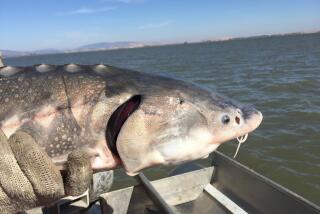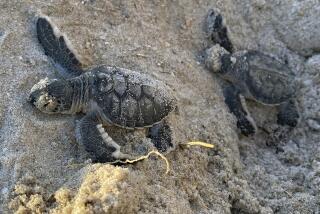Loggerhead sea turtle protection modified
Federal agencies have changed the designation ofloggerhead sea turtles from a single threatened species to nine distinct population segments; five are listed as endangered and four are listed as threatened.
The National Oceanic and Atmospheric Administration and U.S. Fish and Wildlife Service said the change will help scientists tailor conservation efforts to deal with threats faced by genetically distinct groups of the species in regions around the world.
The decision Friday was in response to legal petitions filed in 2007 by the Center for Biological Diversity, the Turtle Island Restoration Network and Oceana for additional protections for the loggerheads.
In March, the agencies proposed listing seven populations as endangered. However, the final statuses of the Northwest Atlantic Ocean and Southeast Indo-Pacific Ocean segments were changed from endangered to threatened after further analysis and public comments including objections from the fishing industry, according to Jim Lecky, NOAA fisheries director of protected resources.
Earlier this year, the proposal to list the Northwest Atlantic population as endangered was questioned by a group of 15 federal lawmakers with oversight of NOAA. Their questions were based on concerns about potential effects on coastal communities, marine industries and commercial and recreational fishing activities.
In an interview Friday, Sandy MacPherson, national sea turtle coordinator for the Fish and Wildlife Service, said: “The trend in nesting female [Northwest Atlantic Ocean]loggerhead sea turtles is relatively flat; their decline is not a precipitous one.”
Catherine Kilduff, an attorney at the Center for Biological Diversity, disagreed. “The failure to recognize that Northwest Atlantic loggerheads are endangered ignores the massive impacts of the BP oil spill and increased threats from shrimp-trawler fisheries on this imperiled population,” she said.
In a break from the usual process, the endangered statuses did not trigger designation of critical habitat zones for the two populations found in the United States, which would have affected future oil drilling, fishing and other activities. Instead, critical habitat will be proposed and determined in a separate action next year.
In the meantime, “I think the impacts will be minor because the animals were already listed worldwide as threatened,” Lecky said. “For example, shrimp trawl fisheries and others will continue to be required to use turtle exclusion devices. There may be some additional conservation measures put in place.”
Loggerhead turtles have continued to decline since the species was listed as threatened in 1978 under the Endangered Species Act. The primary causes include incidental capture in fishing nets and long lines, lost beach nesting habitat and harvesting of eggs, wildlife authorities say.
Loggerhead nests in the U.S. are found along the Atlantic and Gulf of Mexico coasts, from southern Virginia through Alabama. The North Pacific population hatches on the Japanese coast, and some juveniles migrate more than 7,500 miles to the coast of Mexico, where they feed in open waters.
Loggerheads grow to about 3 feet in length and can weigh about 250 pounds. Their broad heads support powerful jaws and enable them to feed on hard-shelled prey, including whelks and conch.
Because loggerheads reach sexual maturity at about 35 years old, it may take decades before scientists can determine whether conservation measures are reflected in sea turtle mortality rates and increased chances of survival, MacPherson said.
“Loggerhead populations across the world need more protection to survive this century,” Kilduff said. “This listing is a wake-up call that a whole host of threats — from oil spills, channel dredging and commercial trawling to longline and gillnet fisheries — continue to kill off turtles faster than the animals can possibly hope to reproduce.”
More to Read
Sign up for Essential California
The most important California stories and recommendations in your inbox every morning.
You may occasionally receive promotional content from the Los Angeles Times.











